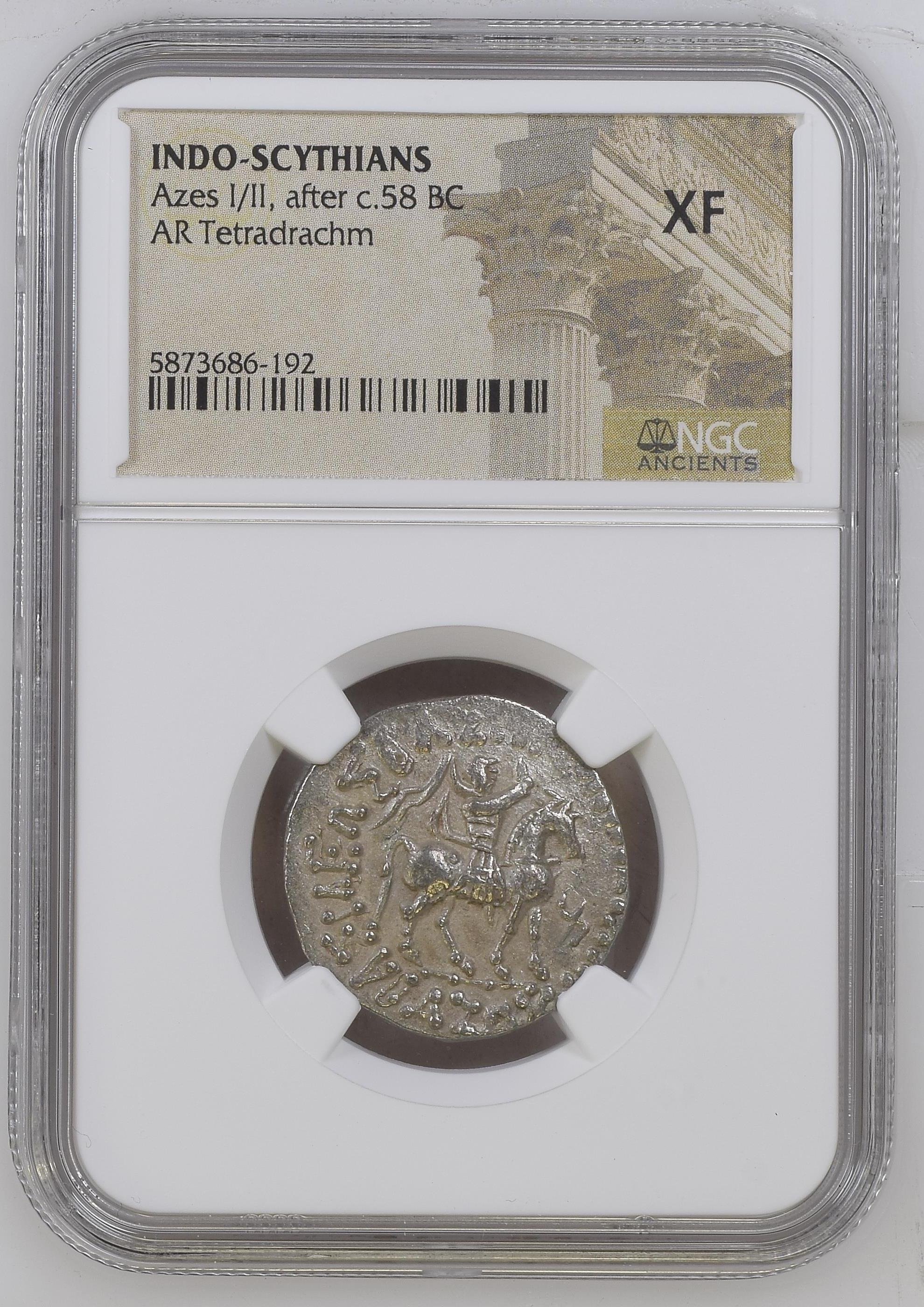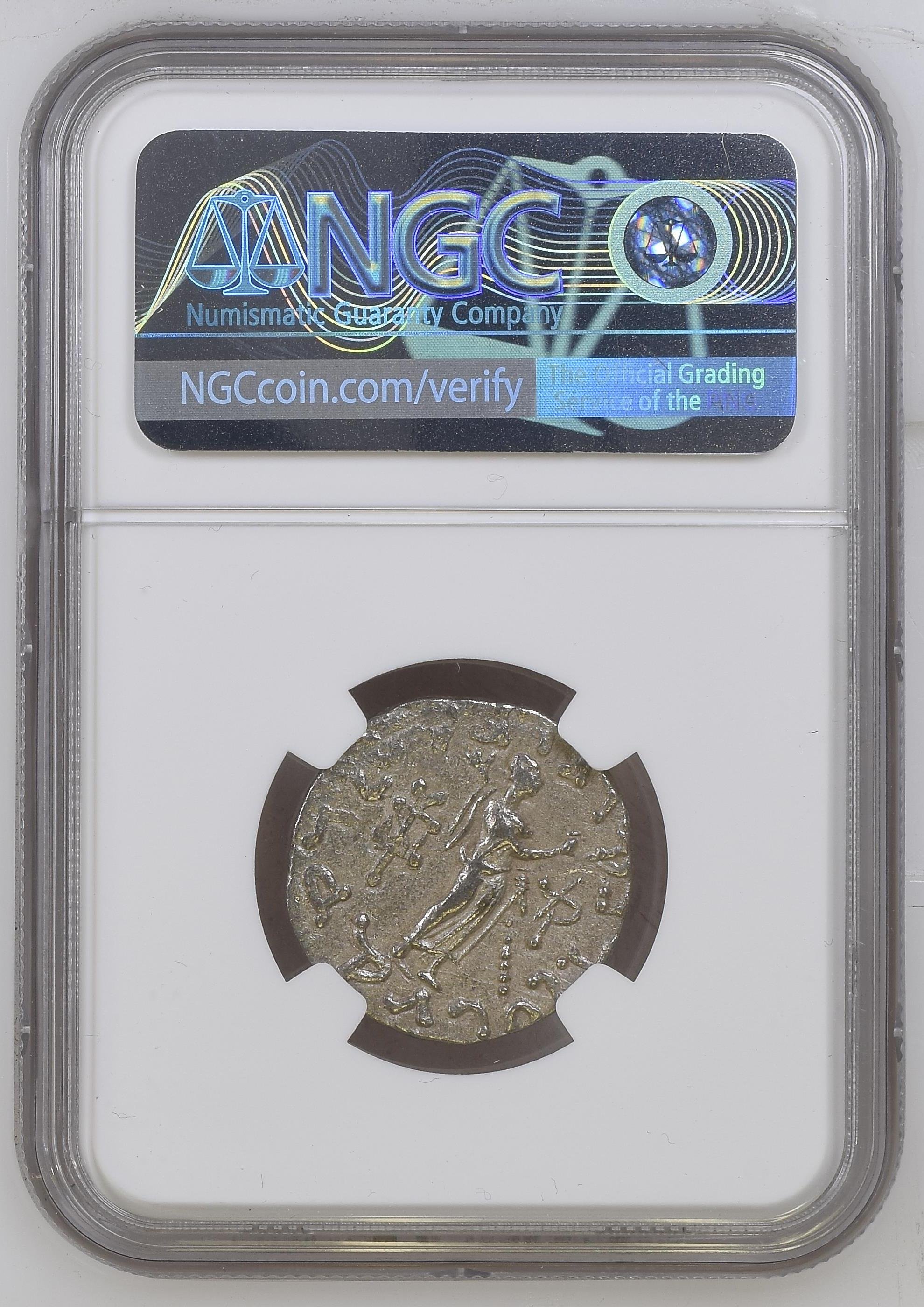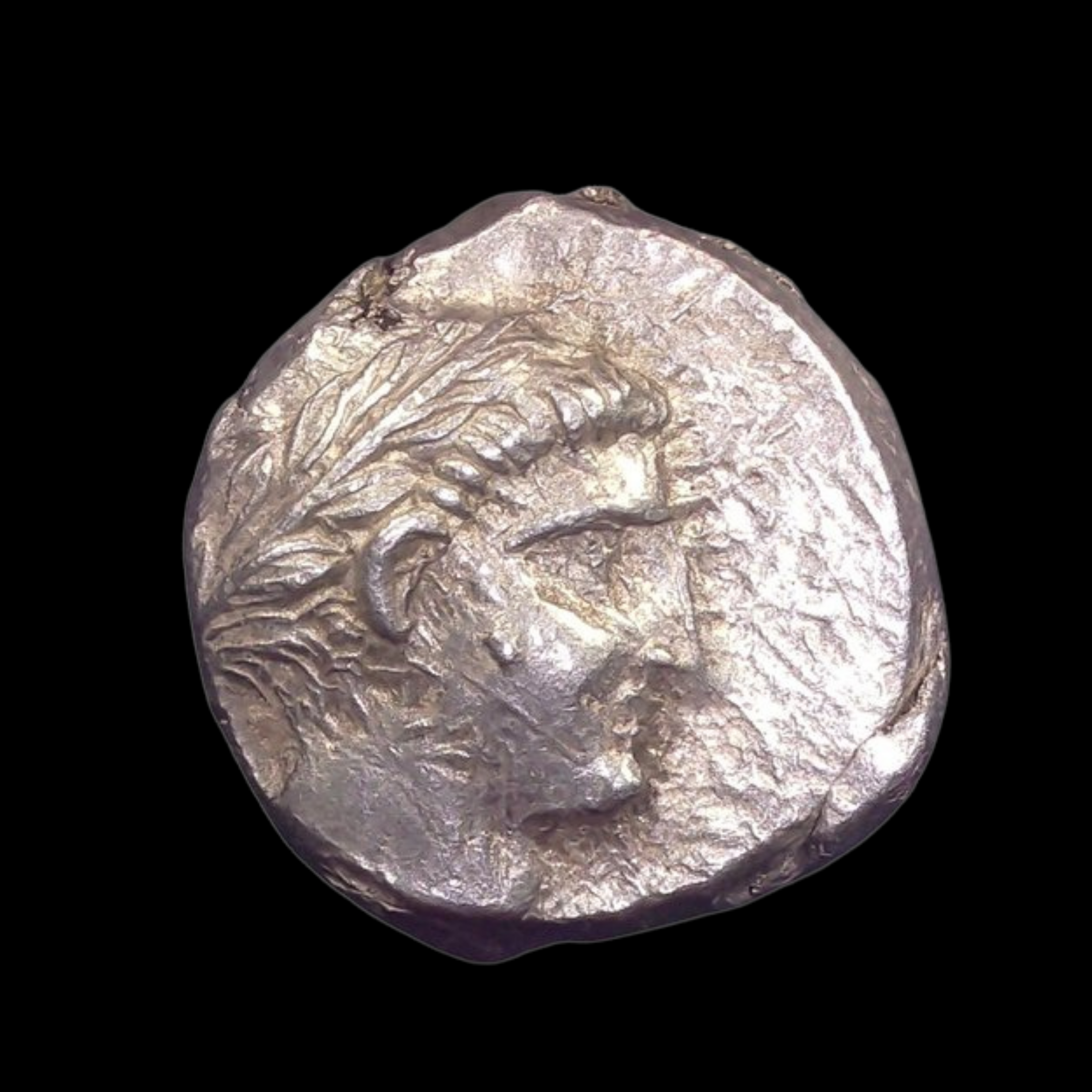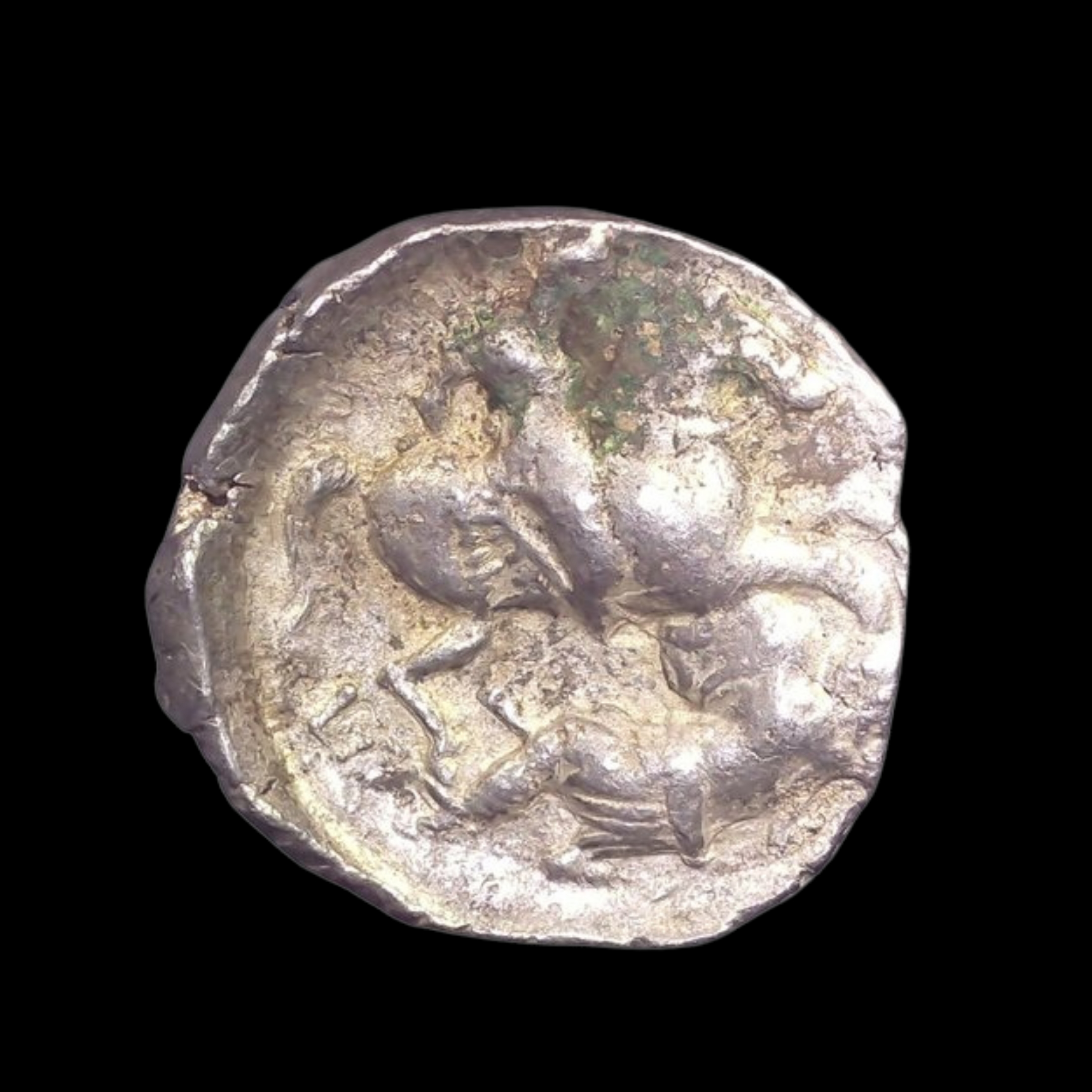 Image 1 of 2
Image 1 of 2

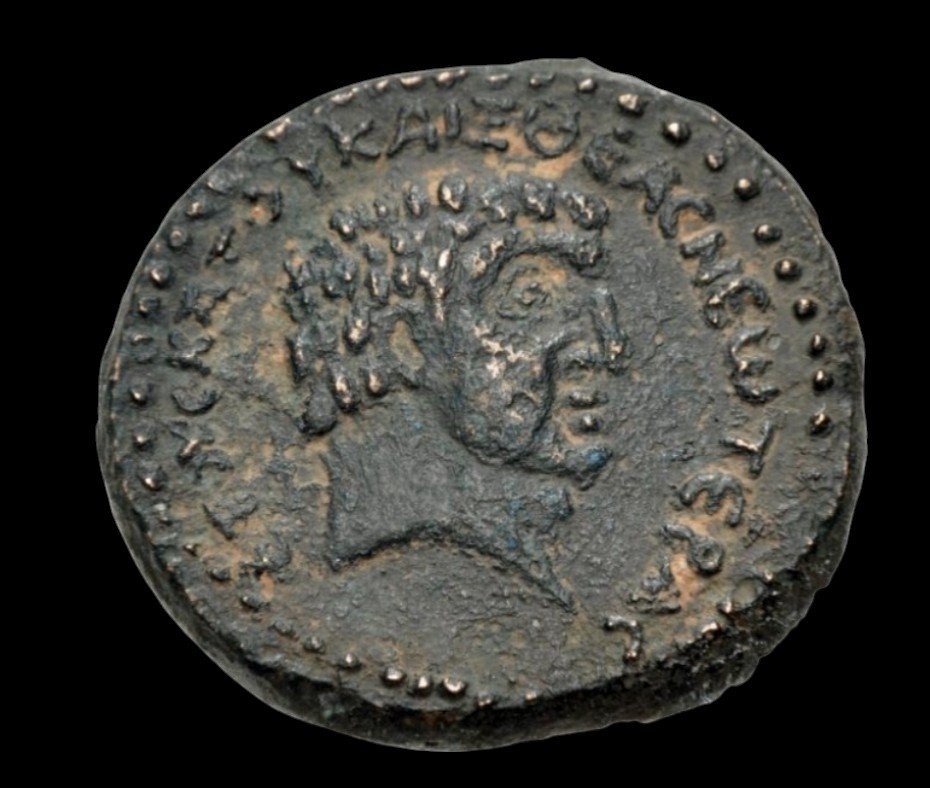 Image 2 of 2
Image 2 of 2



Ancient Bronze Coin from Northern Syria: Made when Mark Antony and Cleopatra ruled the region (about 2,050 years ago)
The Athenian Tetradrachm, a remarkable silver coin, hails from ancient Athens (modern-day Greece) and dates back to the 5th century BCE, a period often considered the height of Athenian power and culture. This coin is notable for its association with the Athenian democracy and the naval might of Athens during the Persian Wars. The tetradrachm was a crucial part of the currency system in classical Greece, serving as a standard of trade and a means of payment for various goods and services while showcasing the city's artistic achievements.
Coin Description:
Front side: The obverse features a beautifully rendered depiction of the goddess Athena, the patroness of the city, wearing a crested helmet and accompanied by an olive branch. Her image symbolizes wisdom and strength, and the intricate details, such as her flowing hair and the ornate helmet, reflect the high level of artistry prevalent during this period.
Back side: The reverse displays an owl, a symbol of wisdom and a common motif associated with Athena. Alongside the owl is an inscription that typically reads “ΑΘΕ,” meaning "of the Athenians," which underscores the coin's origin. The owl is depicted in a sitting posture, with its large eyes looking forward, framed by an olive wreath beneath it.
Technical Details:
Silver composition: 94% silver, 6% copper
Denomination: Tetradrachm (equivalent to four drachmas, a common unit of currency in ancient Greece)Catalog/reference numbers: Sear 2526
Certification and grade information: Uncertified, Fine to Very Fine condition
Date/period of minting: Circa 455-404 BCE
Historical Significance: The Athenian tetradrachm played a crucial role in the economic and cultural landscape of ancient Athens. Minted during a time of expansion and democratic reform, it emerged amidst the backdrop of the Persian Wars and the subsequent establishment of the Delian League, an alliance led by Athens. This coin facilitated trade not only within Greece but also across the Mediterranean, serving as a trusted currency for merchants and travelers alike. The prominence of the tetradrachm in trade allowed Athens to consolidate its influence and wealth, fostering an environment that sparked philosophical and artistic advancements. The coin reflects Athens' identity, representing both their military strength and cultural sophistication during a transformative period in their history.
The Athenian Tetradrachm, a remarkable silver coin, hails from ancient Athens (modern-day Greece) and dates back to the 5th century BCE, a period often considered the height of Athenian power and culture. This coin is notable for its association with the Athenian democracy and the naval might of Athens during the Persian Wars. The tetradrachm was a crucial part of the currency system in classical Greece, serving as a standard of trade and a means of payment for various goods and services while showcasing the city's artistic achievements.
Coin Description:
Front side: The obverse features a beautifully rendered depiction of the goddess Athena, the patroness of the city, wearing a crested helmet and accompanied by an olive branch. Her image symbolizes wisdom and strength, and the intricate details, such as her flowing hair and the ornate helmet, reflect the high level of artistry prevalent during this period.
Back side: The reverse displays an owl, a symbol of wisdom and a common motif associated with Athena. Alongside the owl is an inscription that typically reads “ΑΘΕ,” meaning "of the Athenians," which underscores the coin's origin. The owl is depicted in a sitting posture, with its large eyes looking forward, framed by an olive wreath beneath it.
Technical Details:
Silver composition: 94% silver, 6% copper
Denomination: Tetradrachm (equivalent to four drachmas, a common unit of currency in ancient Greece)Catalog/reference numbers: Sear 2526
Certification and grade information: Uncertified, Fine to Very Fine condition
Date/period of minting: Circa 455-404 BCE
Historical Significance: The Athenian tetradrachm played a crucial role in the economic and cultural landscape of ancient Athens. Minted during a time of expansion and democratic reform, it emerged amidst the backdrop of the Persian Wars and the subsequent establishment of the Delian League, an alliance led by Athens. This coin facilitated trade not only within Greece but also across the Mediterranean, serving as a trusted currency for merchants and travelers alike. The prominence of the tetradrachm in trade allowed Athens to consolidate its influence and wealth, fostering an environment that sparked philosophical and artistic advancements. The coin reflects Athens' identity, representing both their military strength and cultural sophistication during a transformative period in their history.
The Athenian Tetradrachm, a remarkable silver coin, hails from ancient Athens (modern-day Greece) and dates back to the 5th century BCE, a period often considered the height of Athenian power and culture. This coin is notable for its association with the Athenian democracy and the naval might of Athens during the Persian Wars. The tetradrachm was a crucial part of the currency system in classical Greece, serving as a standard of trade and a means of payment for various goods and services while showcasing the city's artistic achievements.
Coin Description:
Front side: The obverse features a beautifully rendered depiction of the goddess Athena, the patroness of the city, wearing a crested helmet and accompanied by an olive branch. Her image symbolizes wisdom and strength, and the intricate details, such as her flowing hair and the ornate helmet, reflect the high level of artistry prevalent during this period.
Back side: The reverse displays an owl, a symbol of wisdom and a common motif associated with Athena. Alongside the owl is an inscription that typically reads “ΑΘΕ,” meaning "of the Athenians," which underscores the coin's origin. The owl is depicted in a sitting posture, with its large eyes looking forward, framed by an olive wreath beneath it.
Technical Details:
Silver composition: 94% silver, 6% copper
Denomination: Tetradrachm (equivalent to four drachmas, a common unit of currency in ancient Greece)Catalog/reference numbers: Sear 2526
Certification and grade information: Uncertified, Fine to Very Fine condition
Date/period of minting: Circa 455-404 BCE
Historical Significance: The Athenian tetradrachm played a crucial role in the economic and cultural landscape of ancient Athens. Minted during a time of expansion and democratic reform, it emerged amidst the backdrop of the Persian Wars and the subsequent establishment of the Delian League, an alliance led by Athens. This coin facilitated trade not only within Greece but also across the Mediterranean, serving as a trusted currency for merchants and travelers alike. The prominence of the tetradrachm in trade allowed Athens to consolidate its influence and wealth, fostering an environment that sparked philosophical and artistic advancements. The coin reflects Athens' identity, representing both their military strength and cultural sophistication during a transformative period in their history.
Cleopatra VII Thea Philopator (Koinē Greek: Κλεοπάτρα Θεά Φιλοπάτωρ lit. 'Cleopatra father-loving goddess';[note 5] 70/69 BC – 10 August 30 BC) was Queen of the Ptolemaic Kingdom of Egypt from 51 to 30 BC, and its last active ruler.[note 6] A member of the Ptolemaic dynasty, she was a descendant of its founder Ptolemy I Soter, a Macedonian Greek general and companion of Alexander the Great.[note 7] Her first language was Koine Greek, and she is the only Ptolemaic ruler known to have learned the Egyptian language.[note 8] After her death, Egypt became a province of the Roman Empire, marking the end of the last Hellenistic-period state in the Mediterranean, a period which had lasted since the reign of Alexander (336–323 BC).[note 9]
In 58 BC, Cleopatra presumably accompanied her father, Ptolemy XII Auletes, during his exile to Rome after a revolt in Egypt (a Roman client state) allowed his daughter and rival, Berenice IV, to claim his throne. Berenice was killed in 55 BC when Ptolemy returned to Egypt with Roman military assistance. When he died in 51 BC, Cleopatra began reigning alongside her brother Ptolemy XIII, but a falling-out between them led to an open civil war. Roman statesman Pompey fled to Egypt after losing the 48 BC Battle of Pharsalus in Greece against his rival Julius Caesar (a Roman dictator and consul) in Caesar's civil war. Pompey had been a political ally of Ptolemy XII, but Ptolemy XIII, at the urging of his court eunuchs, had Pompey ambushed and killed before Caesar arrived and occupied Alexandria. Caesar then attempted to reconcile the rival Ptolemaic siblings, but Ptolemy's chief adviser, Potheinos, viewed Caesar's terms as favoring Cleopatra, so his forces besieged her and Caesar at the palace. Shortly after the siege was lifted by reinforcements, Ptolemy XIII died in the Battle of the Nile; Cleopatra's half-sister Arsinoe IV was eventually exiled to Ephesus for her role in carrying out the siege. Caesar declared Cleopatra and her brother Ptolemy XIV joint rulers but maintained a private affair with Cleopatra that produced a son, Caesarion. Cleopatra traveled to Rome as a client queen in 46 and 44 BC, where she stayed at Caesar's villa. After Caesar's assassination, followed shortly afterwards by that of Ptolemy XIV (on Cleopatra's orders), she named Caesarion co-ruler as Ptolemy XV.
You Might Also Like








